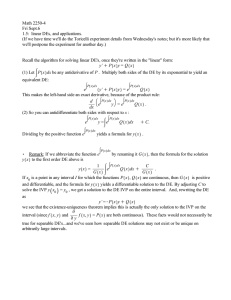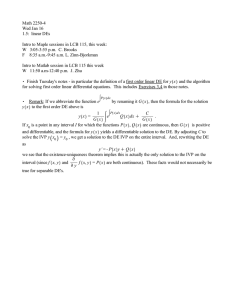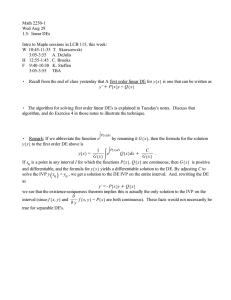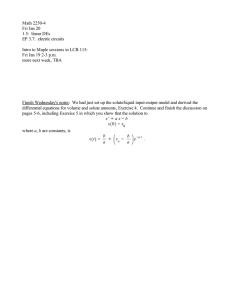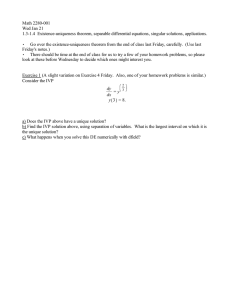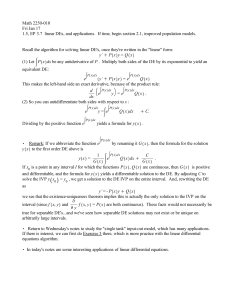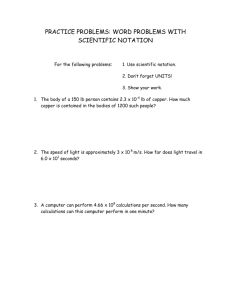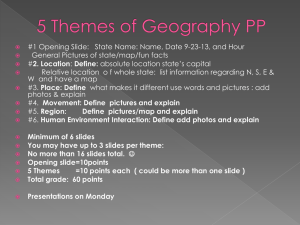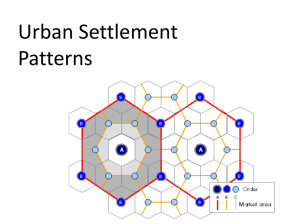Math 2280-001 Fri Jan 23 Section 1.5, linear differential equations:
advertisement
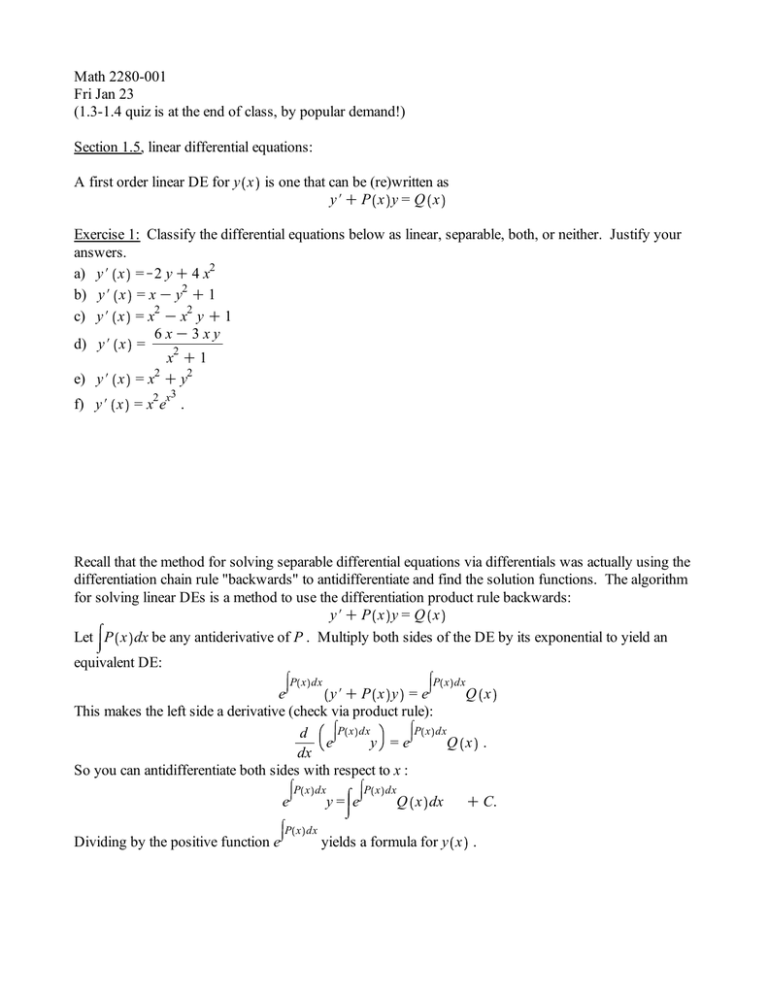
Math 2280-001 Fri Jan 23 (1.3-1.4 quiz is at the end of class, by popular demand!) Section 1.5, linear differential equations: A first order linear DE for y x is one that can be (re)written as y#C P x y = Q x Exercise 1: Classify the differential equations below as linear, separable, both, or neither. Justify your answers. a) y# x =K2 y C 4 x2 b) y# x = x K y2 C 1 c) y# x = x2 K x2 y C 1 6 xK3 x y d) y# x = x2 C 1 e) y# x = x2 C y2 3 f) y# x = x2 ex . Recall that the method for solving separable differential equations via differentials was actually using the differentiation chain rule "backwards" to antidifferentiate and find the solution functions. The algorithm for solving linear DEs is a method to use the differentiation product rule backwards: y#C P x y = Q x Let P x dx be any antiderivative of P . Multiply both sides of the DE by its exponential to yield an equivalent DE: P x dx P x dx e y#C P x y = e Q x This makes the left side a derivative (check via product rule): P x dx P x dx d e y =e Q x . dx So you can antidifferentiate both sides with respect to x : e Dividing by the positive function e P x dx P x dx y= e P x dx Q x dx C C. yields a formula for y x . P x dx , Remark: If we abbreviate the function e by renaming it G x , then the formula for the solution y x to the first order DE above is P x dx 1 C y x = e Q x dx C . G x G x If x0 is a point in any interval I for which the functions P x , Q x are continuous, then G x is positive and differentiable, and the formula for y x yields a differentiable solution to the DE. By adjusting C to solve the IVP y x0 = y0 , we get a solution to the DE IVP on the entire interval. And, rewriting the DE as y#=KP x y C Q x we see that the existence-uniqueness theorem implies this is actually the only solution to the IVP on the v interval (since f x, y and f x, y = P x are both continuous). These facts would not necessarily be vy true for separable DE's...and we've seen how separable DE solutions may not exist or be unique on arbitrarily large intervals. Exercise 2: Solve the differential equation y# x =K2 y C 4 x2 , and compare your solutions to the dfield plot below. > with DEtools : # load differential equations library > deqtn2 d y# x =K2$y x C 4$x2 : #notice you must use $ for multiplication in Maple, # and write y x rather than y. dsolve deqtn2, y x ; # Maple check > Exercise 3: Find all solutions to the linear (and separable) DE 6 xK3 x y y# x = x2 C 1 Hint: as you can verify below, the general solution is y x = 2 C C x2 C 1 > with DEtools : dsolve 3 2 K . An extremely important class of modeling problems that lead to linear DE's involve input-output models. These have diverse applications ranging from bioengineering to environmental science. For example, The "tank" below could actually be a human body, a lake, or a pollution basin, in different applications. For the present considerations, consider a tank holding liquid, with volume V t (e.g units l ). Liquid l gm flows in at a rate ri (e.g. units ), and with solute concentration ci (e.g. units ). Liquid flows out at a s l rate ro , and with concentration c0 . We are attempting to model the volume V t of liquid and the amount of solute x t (e.g. units gm ) in the tank at time t , given V 0 = V0 , x 0 = x0 . We assume the solution in the tank is well-mixed, so that we can treat the concentration as uniform throughout the tank, i.e. x t gm co = . V t l See the diagram below. Exercise 4: Under these assumptions use your modeling ability and Calculus to derive the following differential equations for V t and x t : a) The DE for V t , which we can just integrate: V# t = ri K r0 t so V t = V0 C 0 ri t K r0 t dt b) The linear DE for x t . x# t = ri ci K ro co = ri ci Kro x# t C ro V x t = ri ci x V Often (but not always) the tank volume remains constant, i.e. ri = ro . If the incoming concentration ci is also constant, then the IVP for solute amount is x#C a x = b x 0 = x0 where a, b are constants. Exercise 5: The constant coefficient initial value problem above will recur throughout the course in various contexts, so let's solve it now. Hint: We will check our answer with Maple first, and see that the solution is b b Ka t x t = C xo K e . a a Exercise 6 (taken from section 1.5 of text) Solve the following pollution problem IVP, to answer the follow-up question: Lake Huron has a relatively constant concentration for a certain pollutant. Since Lake Huron is the primary water source for Lake Erie, this is also the usual pollutant concentration in Lake Erie Due to an industrial accident, however, Lake Erie has suddenly obtained a concentration five times as large. Lake Erie has a volume of 480 km3 , and water flows into and out of Lake Erie at a rate of 350 km3 per year. Essentially all of the in-flow is from Lake Huron (see below). We expect that as time goes by, the water from Lake Huron will flush out Lake Erie. Assuming that the pollutant concentration is roughly the same everywhere in Lake Erie, about how long will it be until this concentration is only twice the original background concentration from Lake Huron? http://www.enchantedlearning.com/usa/statesbw/greatlakesbw.GIF a) Set up the initial value problem. Maybe use symbols c for the background concentration (in Huron), V = 480 km3 km3 r = 350 y b) Solve the IVP, and then answer the question.
